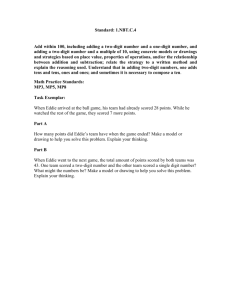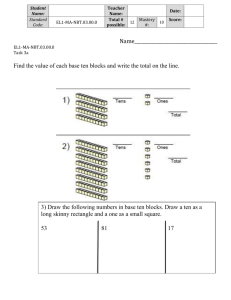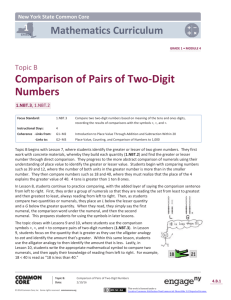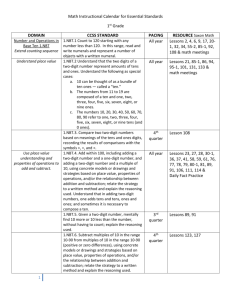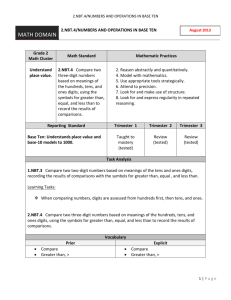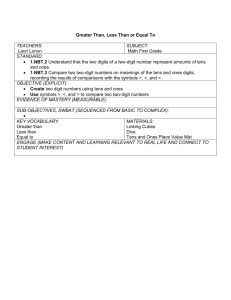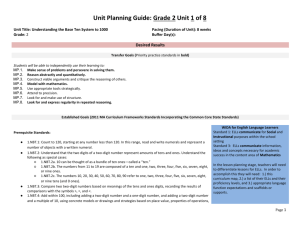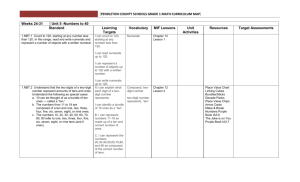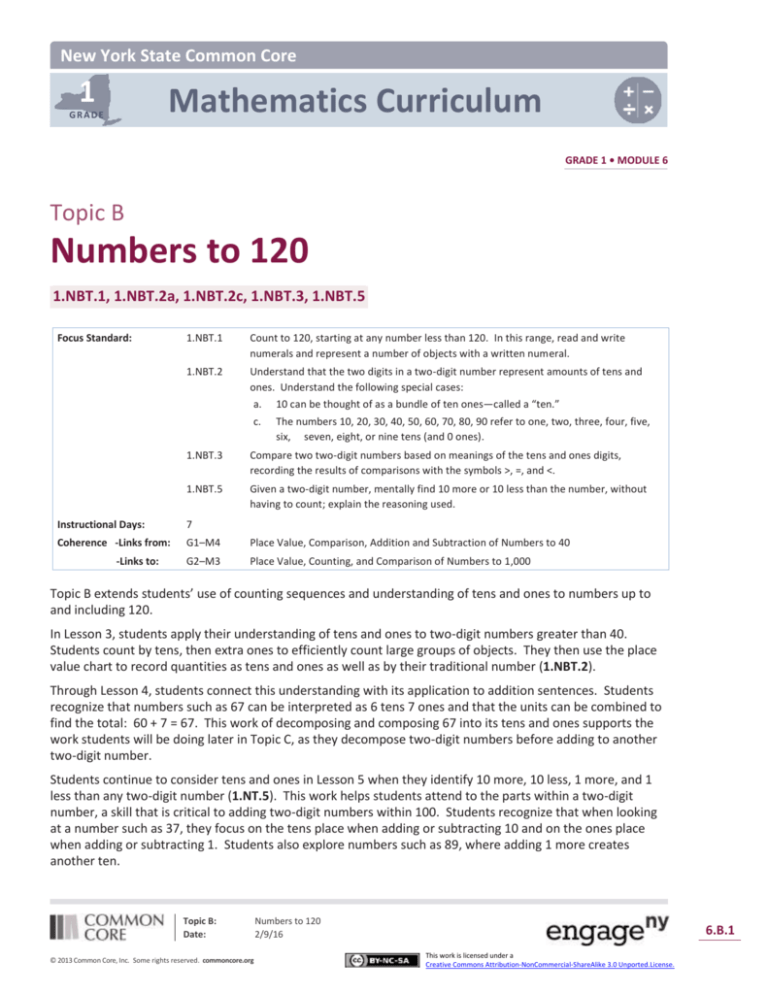
New York State Common Core
1
Mathematics Curriculum
GRADE
GRADE 1 • MODULE 6
Topic B
Numbers to 120
1.NBT.1, 1.NBT.2a, 1.NBT.2c, 1.NBT.3, 1.NBT.5
Focus Standard:
1.NBT.1
Count to 120, starting at any number less than 120. In this range, read and write
numerals and represent a number of objects with a written numeral.
1.NBT.2
Understand that the two digits in a two-digit number represent amounts of tens and
ones. Understand the following special cases:
a.
10 can be thought of as a bundle of ten ones—called a “ten.”
c.
The numbers 10, 20, 30, 40, 50, 60, 70, 80, 90 refer to one, two, three, four, five,
six, seven, eight, or nine tens (and 0 ones).
1.NBT.3
Compare two two-digit numbers based on meanings of the tens and ones digits,
recording the results of comparisons with the symbols >, =, and <.
1.NBT.5
Given a two-digit number, mentally find 10 more or 10 less than the number, without
having to count; explain the reasoning used.
Instructional Days:
7
Coherence -Links from:
G1–M4
Place Value, Comparison, Addition and Subtraction of Numbers to 40
G2–M3
Place Value, Counting, and Comparison of Numbers to 1,000
-Links to:
Topic B extends students’ use of counting sequences and understanding of tens and ones to numbers up to
and including 120.
In Lesson 3, students apply their understanding of tens and ones to two-digit numbers greater than 40.
Students count by tens, then extra ones to efficiently count large groups of objects. They then use the place
value chart to record quantities as tens and ones as well as by their traditional number (1.NBT.2).
Through Lesson 4, students connect this understanding with its application to addition sentences. Students
recognize that numbers such as 67 can be interpreted as 6 tens 7 ones and that the units can be combined to
find the total: 60 + 7 = 67. This work of decomposing and composing 67 into its tens and ones supports the
work students will be doing later in Topic C, as they decompose two-digit numbers before adding to another
two-digit number.
Students continue to consider tens and ones in Lesson 5 when they identify 10 more, 10 less, 1 more, and 1
less than any two-digit number (1.NT.5). This work helps students attend to the parts within a two-digit
number, a skill that is critical to adding two-digit numbers within 100. Students recognize that when looking
at a number such as 37, they focus on the tens place when adding or subtracting 10 and on the ones place
when adding or subtracting 1. Students also explore numbers such as 89, where adding 1 more creates
another ten.
Topic B:
Date:
© 2013 Common Core, Inc. Some rights reserved. commoncore.org
Numbers to 120
2/9/16
6.B.1
This work is licensed under a
Creative Commons Attribution-NonCommercial-ShareAlike 3.0 Unported.License.
Topic B 1•6
NYS COMMON CORE MATHEMATICS CURRICULUM
During Lesson 6, students practice comparing numbers using the symbols >, =, and < (1.NBT.3). They
compare numbers such as 65 and 75, as well as numbers in various unit form combinations, such as 7 tens 5
ones, 5 ones 7 tens, and 6 tens 15 ones. Through these explorations, students consider ways that each
number can be decomposed and recomposed.
In Lesson 7, students work with the counting sequence to 120 (1.NBT.1). Starting at 78, students use Hide
Zero cards to build each number. Their strong familiarity with counting from 0 to 20 and back is then related
to the sequence from 100 to 120, helping students recognize that their prior knowledge can help them
succeed at this new level.
Lesson 8 continues the use of the Hide Zero cards, as students use 5-group cards of 10 to write numbers
within place value charts. Students represent 100 as 10 tens and then represent 101 as 10 tens and 1 one.
This work with the unit form of numbers to 120 supports students’ understanding of the written numerals
101 through 109, which are the most challenging to write (1.NBT.1).
Following students’ work with the unit form of numbers to 120, students then represent a number of objects
in Lesson 9, presented concretely and pictorially, with the written numeral (1.NBT.1).
A Teaching Sequence Towards Mastery of Numbers to 120
Objective 1: Use the place value chart to record and name tens and ones within a two-digit number up
to 100.
(Lesson 3)
Objective 2: Write and interpret two-digit numbers to 100 as addition sentences that combine tens and
ones.
(Lesson 4)
Objective 3: Identify 10 more, 10 less, 1 more, and 1 less than a two-digit number within 100.
(Lesson 5)
Objective 4: Use the symbols >, =, and < to compare quantities and numerals to 100.
(Lesson 6)
Objective 5: Count and write numbers to 120. Use Hide Zero cards to relate numbers 0 to 20 to 100 to
120.
(Lesson 7)
Objective 6: Count to 120 in unit form using only tens and ones. Represent numbers to 120 as tens and
ones on the place value chart.
(Lesson 8)
Objective 7: Represent up to 120 objects with a written numeral.
(Lesson 9)
Topic B:
Date:
© 2013 Common Core, Inc. Some rights reserved. commoncore.org
Numbers to 120
2/9/16
6.B.2
This work is licensed under a
Creative Commons Attribution-NonCommercial-ShareAlike 3.0 Unported.License.


